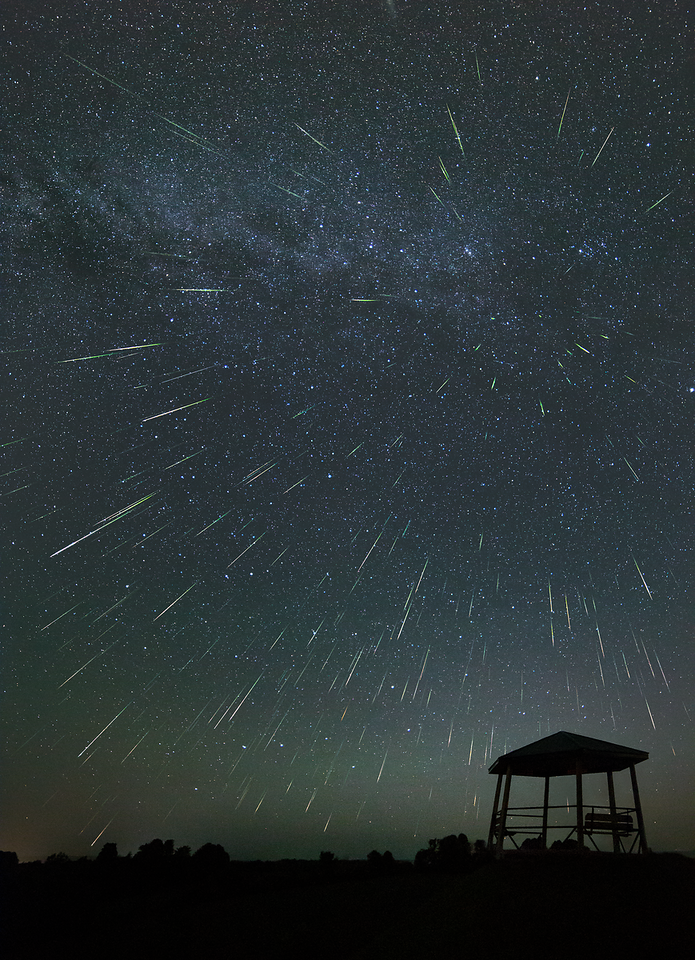 Pierre Martin created this composite image of 282 Perseids captured between 0650 UT (02:50am EDT) and 0900 UT (05:00am EDT) on the night of August 13/14 2021. The equipment and image details: Canon 6D at ISO 6400, 20 sec exposures, Rokinon 14mm f/2.8 lens. Setup was mounted on tripod unguided. 364 continuous exposures were made of which 282 meteors were found, and digitally combined into this image (a few additional Perseids were found but are not included here due to sky rotation). Sporadics and other minor shower meteors are not included. Photographed near Westmeath, Ontario, Canada. ©Pierre Martin
Pierre Martin created this composite image of 282 Perseids captured between 0650 UT (02:50am EDT) and 0900 UT (05:00am EDT) on the night of August 13/14 2021. The equipment and image details: Canon 6D at ISO 6400, 20 sec exposures, Rokinon 14mm f/2.8 lens. Setup was mounted on tripod unguided. 364 continuous exposures were made of which 282 meteors were found, and digitally combined into this image (a few additional Perseids were found but are not included here due to sky rotation). Sporadics and other minor shower meteors are not included. Photographed near Westmeath, Ontario, Canada. ©Pierre MartinDuring this period, the moon reaches its new phase on Tuesday September 7th. At that time the moon lies near the sun and is invisible at night. This weekend the waning crescent moon will rise shortly before dawn and will not interfere with meteor observing. Late in this period the waxing crescent moon will enter the evening sky but again it will set near the end of dusk and will not interfere with meteor observing. The estimated total hourly meteor rates for evening observers this week is near 4 as seen from mid-northern latitudes (45N) and 3 as seen from tropical southern locations (25S). For morning observers, the estimated total hourly rates should be near 14 as seen from mid-northern latitudes (45N) and 9 as seen from tropical southern locations (25S). The actual rates will also depend on factors such as personal light and motion perception, local weather conditions, alertness, and experience in watching meteor activity. Note that the hourly rates listed below are estimates as viewed from dark sky sites away from urban light sources. Observers viewing from urban areas will see less activity as only the brighter meteors will be visible from such locations.
The radiant (the area of the sky where meteors appear to shoot from) positions and rates listed below are exact for Saturday night/Sunday morning September 4/5. These positions do not change greatly day to day so the listed coordinates may be used during this entire period. Most star atlases (available at science stores and planetariums) will provide maps with grid lines of the celestial coordinates so that you may find out exactly where these positions are located in the sky. I have also included charts of the sky that display the radiant positions for evening, midnight, and morning. The center of each chart is the sky directly overhead at the appropriate hour. These charts are oriented for facing south but can be used for any direction by rotating the charts to the desired direction. A planisphere or computer planetarium program is also useful in showing the sky at any time of night on any date of the year. Activity from each radiant is best seen when it is positioned highest in the sky, either due north or south along the meridian, depending on your latitude. It must be remembered that meteor activity is rarely seen at the radiant position. Rather they shoot outwards from the radiant, so it is best to center your field of view so that the radiant lies at the edge and not the center. Viewing there will allow you to easily trace the path of each meteor back to the radiant (if it is a shower member) or in another direction if it is sporadic. Meteor activity is not seen from radiants that are located far below the horizon. The positions below are listed in a west to east manner in order of right ascension (celestial longitude). The positions listed first are located further west therefore are accessible earlier in the night while those listed further down the list rise later in the night.
These sources of meteoric activity are expected to be active this week.
.
The center of the large Anthelion (ANT) radiant is currently located at 23:40 (355) -021. This position lies in western Pisces, 3 degrees south of the 4th magnitude star known as lambda Piscium. Due to the large size of this radiant, Anthelion activity may also appear from northwestern Cetus, northeastern Aquarius, and western Pisces. This radiant is best placed near 0200 LST, when it lies on the meridian and is located highest in the sky. Rates at this time should be near 2 per hour no matter your location. With an entry velocity of 30 km/sec., the average Anthelion meteor would be of slow velocity.
The September epsilon Perseids (SPE) are active from September 2-23, with maximum activity occurring on the 9th. The current position of the radiant lies at 02:52 (043) +39. This area of the sky lies in southwestern Perseus, 1 degree north of the 4th magnitude star known as 16 Persei. The famous eclipsing binary star known as Algol (beta Persei) lies 4 degrees to the northeast. This radiant is best placed near 0500 LST, when it lies on the meridian and is located highest in the sky. Rates at this time should be near 1 per hour as seen from the Northern Hemisphere and less than 1 as seen from south of the equator. For observers in the Northern Hemisphere, rates should increase to near 3 per hour on September 9th. There have been outbursts from this source in the past, but none are predicted for this year. With an entry velocity of 64 km/sec., the average meteor would be of swift velocity.
The eta Eridanids (ERI) are active from a radiant near 04:25 (066) -05. This position lies in northeastern Eridanus, near the spot occupied by the dim star known as xi Eridani. This source is active until September 10th, with maximum activity occurring on August 6th. Current rates would be less than 1 per hour no matter your location. These meteors are best seen during the last dark hour prior to dawn when the radiant lies highest above the horizon in a dark sky. With an entry velocity of 64 km/sec., the average meteor from this source would be of swift speed. Note that this position is very close to the radiant of the nu Eridanids. Care must be taken to separate the two sources.
As seen from the mid-northern hemisphere (45N) one would expect to see approximately 11 sporadic meteors per hour during the last hour before dawn as seen from rural observing sites. Evening rates would be near 3 per hour. As seen from the tropical southern latitudes (25S), morning rates would be near 7 per hour as seen from rural observing sites and 2 per hour during the evening hours. Locations between these two extremes would see activity between the listed figures.
|
SHOWER |
DATE OF MAXIMUM ACTIVITY | CELESTIAL POSITION | ENTRY VELOCITY | CULMINATION | HOURLY RATE | CLASS |
| RA (RA in Deg.) DEC | Km/Sec | Local Summer Time | North-South | |||
| Anthelion (ANT) | – | -23:40 (355) -01 | 30 | 02:00 | 2 – 2 | II |
| September epsilon Perseids (SPE) | Sep 09 | 02:52 (043) +39 | 64 | 06:00 | 1 – <1 | II |
| eta Eridanids (ERI) | Aug 06 | 04:25 (066) -05 | 64 | 07:00 | <1 – <1 | II |


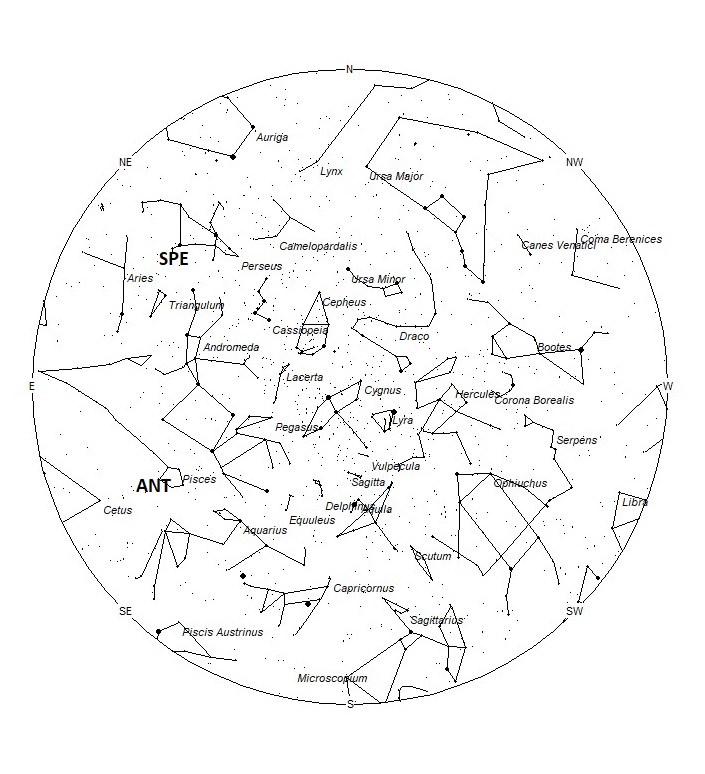
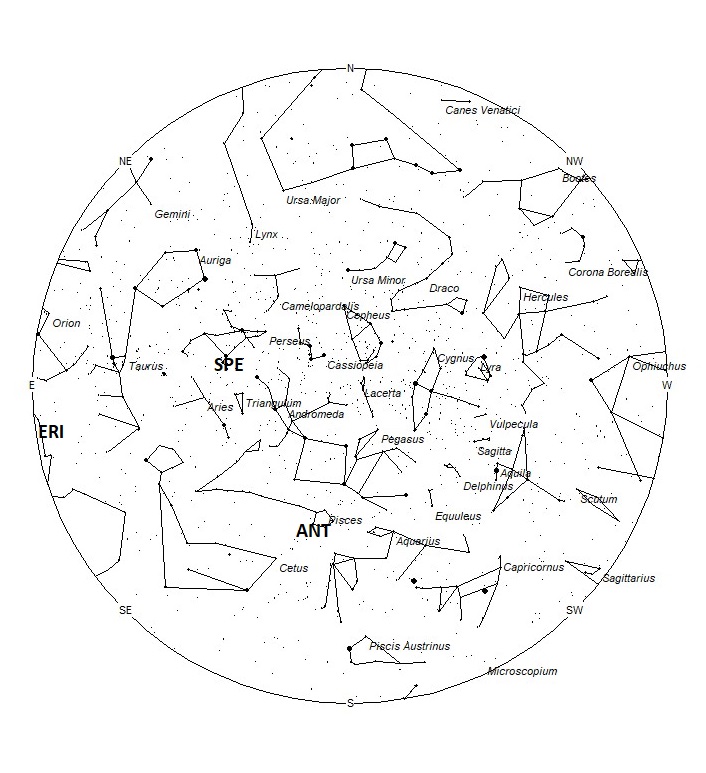
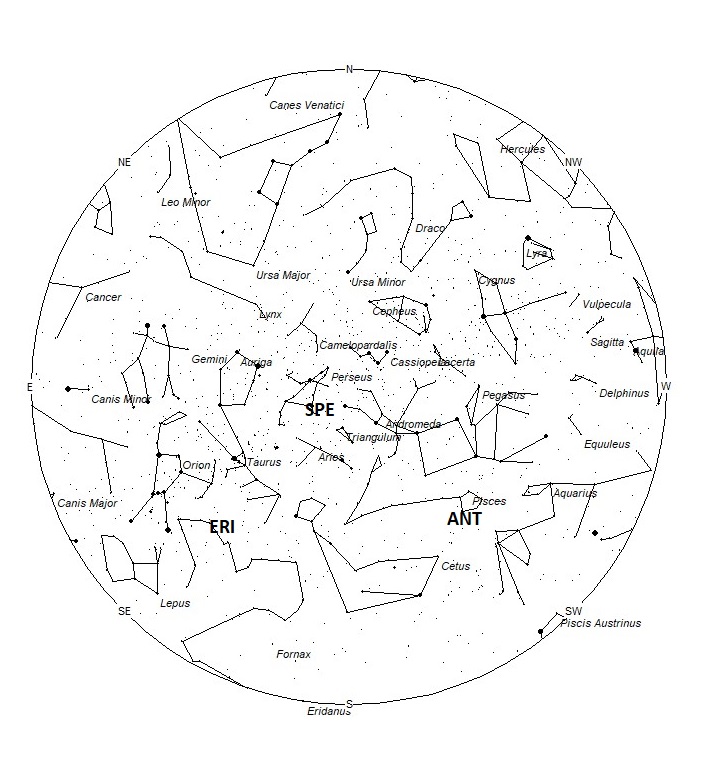

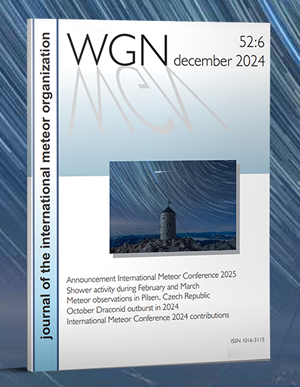
 You saw something bright and fast? Like a huge shooting star? Report it: it may be a fireball.
You saw something bright and fast? Like a huge shooting star? Report it: it may be a fireball.  You counted meteors last night? Share your results with us!
You counted meteors last night? Share your results with us!  You took a photo of a meteor or fireball? You have a screenshot of your cam? Share it with us!
You took a photo of a meteor or fireball? You have a screenshot of your cam? Share it with us!  You caught a meteor or fireball on video? Share your video with us!
You caught a meteor or fireball on video? Share your video with us!